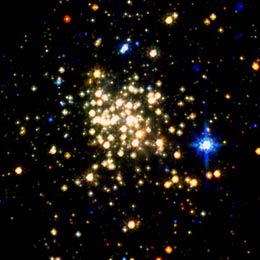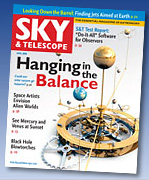The Most Massive Stars

In a paper published this week in the British journal Nature, Donald F. Figer (Space Telescope Science Institute) presents Hubble Space Telescope observations of the richest young star cluster in the Milky Way Galaxy. The most luminous (and hence most massive) stars in the cluster show a sharp cutoff in initial mass at about 130 solar masses. The cluster, known as the Arches Cluster, resides near the galactic center and contains thousands of stars, some of which shine with millions of times the intensity of the Sun. Adopting a conservative approach, Figer concludes that this 2-million-year-old cluster produced no stars greater than 150 solar masses. His result is consistent with studies of nine other young star clusters by a group led by Sally Oey (University of Michigan).
"The 100- to 150-solar-mass range has indeed been talked about as a limit for a long time, but theory does not derive it with any precision," says University of California, Santa Cruz astrophysicist Stan Woosley. "The existence of a sharp cutoff has not been demonstrated observationally with such significance before."
"My concern is the firmness which Figer attaches to his 150-solar-mass upper limit," says University of Florida astronomer Steve Eikenberry. "He basically takes an observed luminosity-based, and thus already soft, mass estimate of 130 solar masses for a single star, and then applies some fudge factor to get 150 solar masses. I think he did a perfectly reasonable job in deriving the best-guess fudge factor for this. However, it is still only a fudge factor, and such things are inherently uncertain."

Indeed, Figer's earlier research allows some wiggle room for much heavier stars. His own Hubble observations of the Pistol Star, an extraordinarily luminous star near the galactic center, indicate a possible mass of up to 250 Suns. But Figer cautions that this star might be a binary system, or an unstable, short-lived product from the merger of two heavy stars. "There is no star in the galaxy that credibly violates the 150-solar-mass upper limit," says Figer. "Wherever it does, something funny is going on."
Even if stars today don't form with masses above 150 Suns, things were very different in the early universe, when stars formed from clouds of pure hydrogen and helium. Models show that stars forming in the absence of heavier elements can attain masses as high as 500 Suns. But these stellar behemoths lived short, furious lives, and exploded billions of years ago, never to form again.






